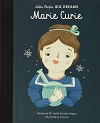|
Little People, Big Dreams: Marie Curie

Last updated Thursday, March 30, 2023
Author: Isabel Sanchez Vegara
Illustrator: Frau Isa
Date of Publication: 2017
ISBN: 1847809626
Grade Level: Kindergarten (GLCs: Click here for grade level guidelines.)
Date(s) Used: Apr. 2023
Synopsis:
When Marie was young, she was unable to go to college because she was a woman. But when she was older, her scientific work was respected around the world. Her discoveries of radium and polonium dramatically helped in the fight against cancer, and she went on to win the Nobel Prize for Physics! This book features stylish and quirky illustrations and extra facts at the back, including a biographical timeline with historical photos and a detailed profile of the scientist's life.
| Note to readers: |
| • |
This is a fairly short book. Readers may want to do a walk through of the book before they read it.
|
| Discussion topics for before reading: |
| • |
What is a dream of yours?
|
| • |
What do you want to be when you grow up?
Vocabulary:
|
| • |
Radium - a silver-white, radioactive metal that is one of the chemical elements (that has 88 protons in each nucleus
|
| • |
Polonium - a chemical element (that has 84 protons in each nucleus) 5,000 times more radioactive than radium.
|
| • |
Note: Polonium, like radium, is a rare and highly reactive metal with 33 isotopes, all of which are unstable. Polonium was named after Marie Curie's home country of Poland and was discovered by Marie and Pierre Curie from uranium ore in 1898. Polonium is not only radioactive but is highly toxic.
|
| Discussion topics for during/after reading: |
| • |
Why do you think Marie wanted to be a scientist and not a princess?
|
| • |
What steps do you think Marie and Pierre took to discover radium and polonium?
|
| • |
How do you think Marie's discoveries helped wounded soldiers?
|
| Special activities: |
| • |
After reading the book, the children could discuss the impact Marie Curie had on the world
|
*Note: These craft ideas are just suggestions.
You can use them, but you don't have to use them.
You can expand upon them, or add your own twist.
Remember, though, that the focus of your time should
not be on the development and execution of a craft;
the focus should be on the read-aloud and the
enjoyment of the book!
|
